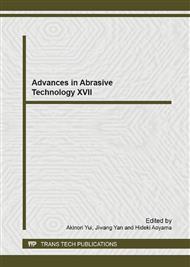p.429
p.435
p.441
p.447
p.452
p.458
p.467
p.473
p.479
A Wear Simulation of the Fixed Soft Abrasive Film Based on Discrete Element Method
Abstract:
A new polishing method by using fixed soft abrasive film is proposed to polish the end-face of the optic fiber connector. In order to study the wear property of the fixed soft abrasive film, the Particle Flow Code program was employed to simulate the interaction of surface topography. The discrete element model of the optic fiber connector and the fixed soft abrasive film were established. Through the interaction of the surface of two models, the process of contact and friction between the fixed soft abrasive film and the end-face of the optic fiber connector could be simulated. Simulation results showed that the main factors affecting the wear of the fixed soft abrasive film were pressure and speed, which mainly affected the normal stress and the tangential stress respectively. And the wear of the surface was mainly related to pressure and speed. The greater the speed and pressure were, the more serious wear of the fixed soft abrasive film was.
Info:
Periodical:
Pages:
452-457
Citation:
Online since:
September 2014
Authors:
Keywords:
Price:
Сopyright:
© 2014 Trans Tech Publications Ltd. All Rights Reserved
Share:
Citation:


